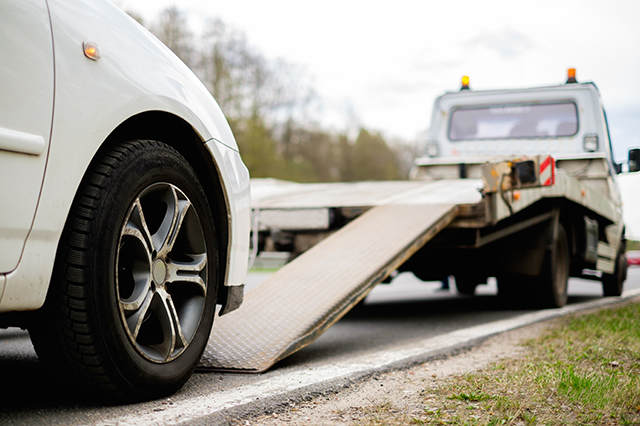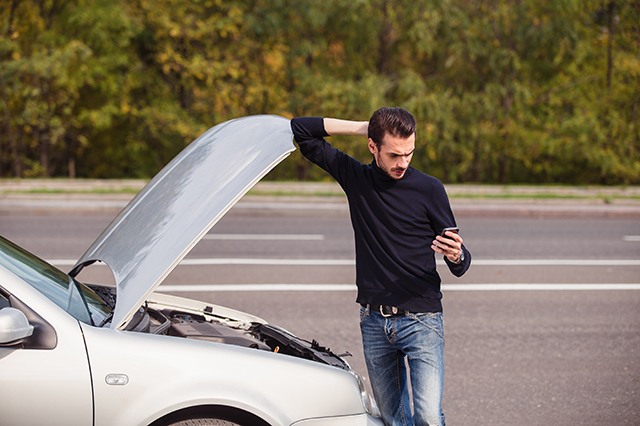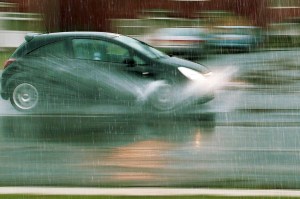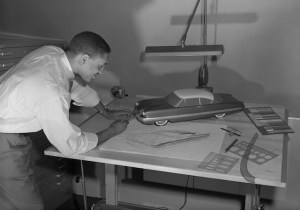Even the most responsible drivers run into car trouble now and then. It’s up to you to know what to do during a car breakdown, and how to keep yourself and others safe if it happens.
Here’s some car breakdown advice from AAA experts.
Why do cars break down?
A car breakdown happens when little problems are ignored long enough to turn into big problems.
There are many reasons for a car breakdown, but some of the most common reasons are an overheated engine, battery failure or a tire blowout.
A car might not start because of a bad starter or loose battery connection, but we’re going to focus on what to do when your car breaks down while you’re driving.
When a car breakdown starts to happen, you might feel the engine stumble or hear it misfire. The vehicle might jerk suddenly, or you could see steam billowing out of the front end.
As a general rule, red warning lights on the instrument cluster indicate serious issues. Think of them like red lights on a traffic signal. If you see one come on, pull over immediately to prevent what could be catastrophic damage, according to AAA’s Car Doctor John Paul.
These are considered the top three warning lights.
- Engine oil pressure: Commonly called the teakettle, this light indicates the engine has lost its supply of oil and harmful metal-on-metal contact is about to occur, followed by major engine damage within seconds.
- Coolant temperature: Often signaled by a thermometer symbol riding waves (accompanied by a temperature gauge in the red), this light indicates a coolant leak or failure of a coolant system part such as the thermostat.
- Charging system failure: This one is the battery light with the plus and minus symbols inside. It illuminates when the alternator stops supplying power to the electrical system. It likely won’t damage anything else, but your car could lose power completely in fewer than 15 minutes.
Another red light to keep an eye on is the one that indicates an issue with the hydraulic brake system. In some cars it appears as “BRAKE,” but check your owner’s manual to make sure of what it looks like in your vehicle. This light could mean your car is low on brake fluid or that you left the parking brake engaged, or it could warn of a serious brake problem that craves the help of a certified automotive technician. Yellow or amber warning lights typically indicate less serious issues, but drivers should still exercise caution and address the problem as soon as possible.
When does a car breakdown typically happen?
It depends. Paul has seen a Chevrolet Malibu running well with 425,000 miles on it. Then again, he’s seen vehicles that get the daylights driven out of them, such as police cars, or ones that have skipped important maintenance services, wear out at 50,000 to 70,000 miles. It comes down to how well the vehicle is maintained, and whether or not important parts are replaced.
- Top off car fluids or change them if they are dirty or contaminated.
- Inflate tires to the manufacturer’s recommended tire pressure.
- Inspect your tires for any visible signs of damage and that the tread is not too worn-down. Try using a quarter to check.
- Test your car battery. (Most of the roadside assistance calls AAA Northeast receives are for battery problems.) AAA Battery Service will come to you to complete this task and, if necessary, replace your battery.
- It’s never a bad idea to have your vehicle undergo a thorough inspection before traveling. An auto repair shop can spot and fix potential problems before they put a detour on your road trip plans. Find a trusted auto shop near you.
What should you do when a car breakdown happens?
If a red light comes on, or you can feel your car failing, pull over as soon as it’s safe to do so. Seconds matter in these situations. (Especially if you see smoke, which can indicate a fire. If your car is on fire, get away from it and call 911 immediately.)
It doesn’t take long for a blown head gasket to cause a blown out water pump, radiator or heating core, says Peyton Knight, owner of the AAA Approved Auto Repair station Knight’s Automotive in Ledgewood, New Jersey.
“The most important thing you can do is watch the gauges and warning lights,” Knight said. “They usually come on early enough that you won’t do major damage if you pull over and shut off the car right away.
“Yes, the car might still go, and you might be tempted to try to make it home, but you’re going to do more damage than it’s worth,” he added.
In the event that a tire blows out, slow down by lifting your foot off the accelerator (do not slam on the brakes). Signal and pull over to the shoulder on the right side of the road, completely out of the flow of traffic and on level ground if you can. Try – keyword “try” – not to freak out, avoid sudden maneuvers and don’t forget to look for other drivers if you must change lanes. When you get to safety, call AAA Roadside Assistance for help. Look for landmarks, street signs or anything else that can help AAA get to your location.
If your engine stops, or you run out of gas, you’re going to need to use your vehicle’s momentum to get out of the road. Again, coast on over to the right shoulder and do not hit the brakes until it’s necessary to stop.
If your vehicle’s engine has overheated, pull over ASAP but do not open the radiator cap (it even warns you not to do this on the cap, so no excuses!). Twisting the cap open on a hot radiator is incredibly dangerous and will only net you a face full of hot steam.
While many of these scenarios require you to pull over as soon as possible, never jeopardize your safety to make it happen. If you find yourself in an inoperable car in the middle of traffic, stay in your car, turn your emergency flashers on and call AAA for help.

What if a car breakdown happens on the highway?
At highway speeds, fast decision-making is even more important.
If your car fails or a tire blows out, decelerate by lifting your foot off the gas and signal your intent to pull over. If you can make it to a rest stop or off the nearest exit, do so. Otherwise, pull off to the left or right shoulder, park and call for help. Do not get out of your vehicle and stay buckled. Other drivers may not see your vehicle, or you if you’re standing in front of it, especially at night or in inclement weather.
If you think your vehicle might get hit, or if you feel unsafe where it broke down, get to a safer location and tell the roadside assistance dispatcher your intentions. Make note of any nearby mile markers or exit signs. This will help your roadside assistance technician find you.
Some people use flares or orange warning triangles to mark their location after a car breakdown. Only do so if you can exit your vehicle on the side opposite the traffic and do not light flares if you smell gasoline leaking from your car. A good way to set up the triangles is to place them 100 feet, 200 feet and 300 feet from the car, Paul said.
How can you prevent a car breakdown?
Here are some steps you can take to reduce the likelihood of a car breakdown.
- Follow the manufacturer’s recommended car care schedule. Parts have a lifespan, and the manufacturer knows better than anyone what that lifespan is.
- Bring the vehicle to a reputable repair shop. AAA Approved Auto Repair facilities conduct a safety inspection during every service, even something routine like an oil change. Thinking ahead helps catch potential problems before they result in a breakdown.
- Conduct regular car maintenance. It’s your responsibility to catch fluid leaks, battery issues and tire problems in between trips to the shop. Once per month, pop the hood and make sure there’s no corrosion on the battery terminals; look for leaks (underneath the car, too) and check the tread depth and air pressure in all tires (including the spare).
How can AAA help with a car breakdown?
AAA Roadside Assistance is available 24/7. Our technicians can help you fix a flat tire, give you a battery jump or tow you to a repair shop for a more serious repair. They know exactly what to do when your car breaks down.
Members can request roadside assistance in several different ways, including by phone (1-800-222-4357), online (AAA.com/GetMoving) or using the AAA Mobile App.
Did we answer your questions about what to do when your car breaks down? Do you have any others? Leave your comments below.
This article has been updated and republished from a previous version.
2 Thoughts on “What to Do When Your Car Breaks Down”
Leave A Comment
Comments are subject to moderation and may or may not be published at the editor’s discretion. Only comments that are relevant to the article and add value to the Your AAA community will be considered. Comments may be edited for clarity and length.















Best option is membership of a breakdown or emergency roadside service, such as the aaa or rac in the uk
Suppose you have your pet with you. I have a pet parrot, for instance. How do you handle that situation?